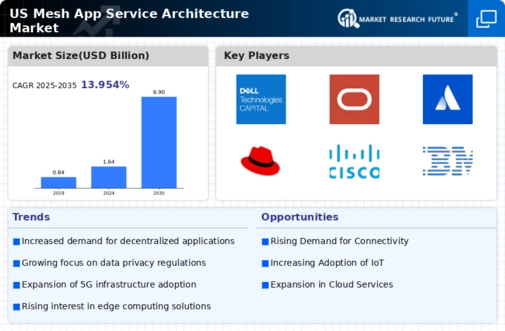The mesh app-service-architecture market is currently characterized by a dynamic competitive landscape, driven by rapid technological advancements and increasing demand for scalable, flexible solutions. Major players such as Amazon (US), Microsoft (US), and Google (US) are at the forefront, each adopting distinct strategies to enhance their market positioning. Amazon (US) focuses on continuous innovation within its AWS platform, emphasizing the integration of AI and machine learning capabilities to optimize service delivery. Meanwhile, Microsoft (US) leverages its Azure platform, prioritizing partnerships and collaborations to expand its service offerings and enhance customer engagement. Google (US) appears to be concentrating on enhancing its cloud infrastructure, aiming to provide seamless integration across various applications, thereby solidifying its competitive edge. Collectively, these strategies contribute to a competitive environment that is increasingly defined by technological prowess and customer-centric solutions.
Key business tactics within this market include localized service offerings and supply chain optimization, which are essential for meeting diverse customer needs. The competitive structure of the mesh app-service-architecture market is moderately fragmented, with several key players exerting substantial influence. This fragmentation allows for a variety of service offerings, yet the dominance of major companies like Amazon (US) and Microsoft (US) shapes the overall market dynamics, often setting benchmarks for innovation and service quality.
In October 2025, Amazon (US) announced the launch of its new AI-driven analytics tool designed to enhance operational efficiency for businesses utilizing its cloud services. This strategic move is significant as it not only reinforces Amazon's commitment to innovation but also positions it as a leader in providing advanced analytical capabilities, which are increasingly sought after by enterprises looking to leverage data for decision-making.
In September 2025, Microsoft (US) expanded its partnership with a leading telecommunications provider to enhance its Azure cloud services, particularly in edge computing. This collaboration is crucial as it enables Microsoft to deliver faster, more reliable services to its customers, thereby enhancing its competitive positioning in the rapidly evolving landscape of cloud computing.
In August 2025, Google (US) unveiled a new suite of tools aimed at improving interoperability between its cloud services and third-party applications. This initiative is strategically important as it addresses a growing demand for seamless integration, allowing businesses to operate more efficiently across different platforms, which could potentially attract a broader customer base.
As of November 2025, the competitive trends within the mesh app-service-architecture market are increasingly influenced by digitalization, sustainability, and the integration of AI technologies. Strategic alliances are becoming more prevalent, as companies recognize the value of collaboration in enhancing service offerings and expanding market reach. Looking ahead, competitive differentiation is likely to evolve, shifting from traditional price-based competition to a focus on innovation, technological advancement, and supply chain reliability. This transition suggests that companies will need to invest significantly in R&D and strategic partnerships to maintain their competitive edge in an ever-changing market.























Leave a Comment